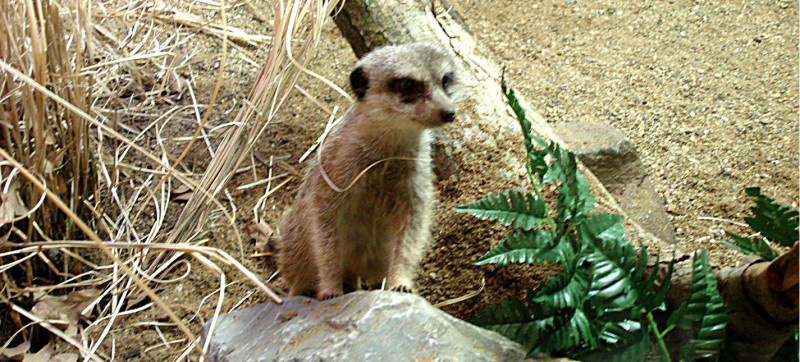Slender-Tailed Meerkat - Suricata suricatta


Habitat:
Deserts where they built large underground networks of tunnels, specifically in the Kalahari Desert. They live in tropical grassland, deserts, and semi-desert.
Range:
Botswana and South Africa
Activity Cycle:
Diurnal
Features:
Mostly brown throughout the body with large black eyes and sharp claws
Size:
The meerkat is a small herpestid weighing on average about 1.61 pounds for males and 1.58 pounds for females. Its long slender body and limbs give it a body length of 10 to 14 inches and an added tail length of 7 to 10 inches.
Social Structure:
Live in mobs, gangs or clans of about 20-30 individuals. Meerkats forage in a group with one "sentry" on guard watching for predators while the others search for food.
Life Expectancy:
Can live up to 12 years in captivity.
Diet:
Meerkats are primarily insectivores, but also eat lizards, snakes, scorpions, spiders, plants, eggs, small mammals, millipedes, centipedes and, more rarely, small birds.
Reproduction:
Meerkats become sexually mature at about one year of age and can have 1 to 5 pups in a litter, with 3 pups being the most common litter size. Wild meerkats may have up to four litters per year. Mating takes place throughout the year and pregnancy last 11 weeks. Live in groups but only the alpha pair (male and female) are the official breeders. The alpha female chases other females off when she’s read to breed. Other females sometimes do mate. If any of them have pups, they try to sneak them in with the alpha females pups to be taken care of. If the alpha female discovers the imposters she will kill and eat them.
Status:
Of little concern in the wild and are part of a Species Survival Plan.
Interesting Facts:
- They are partially immune to certain venoms; they are immune to the very strong venom of the scorpions of the Kalahari Desert.
- Work together when foraging, with one acting as a sentry to alert the others of a potential predator.
- It has recently been noted that meerkat calls may carry specific meanings, with specific calls indicating the approach of snakes, birds of prey, or other predators.
- Burrows are complex and may have up to 90 entrances and different levels.
- The dark patches around their eyes help protect the animal’s vision in harsh sunlight.
- Their ears fold back to keep out dirt as they tunnel.

AZA cooperatively manages this species as a Species Survival Plan® Program.
Prices
- Adult (13 and over)$12.50
- Child (2 - 12)$9.00
- Child (1 and Under)FREE
- Senior (65+)$11.50
- Active Military$11.50
We begin transferring animals to evening (off exhibit) holding at 4:30 each night.
Find Us
2320 N. Prospect Rd.
Peoria, IL 61603
Phone: 309-686-3365
Open Daily 10:00-5:00
Last admission at 4:30
